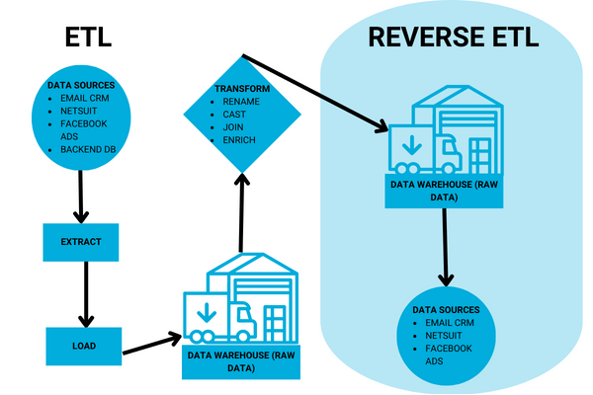Reverse ETL (Extract, Transform, Load) is an approach to data processing that reverses the order in which traditional ETL processes take place.

Pretty interesting right? Well, I tried to get ChatGPT to write a joke about reverse ETL. Now, after trying myself, I came up blank. Reverse ETL might be a great source of marketing success and clean data, but less of a source of rib-ticklin' jokes. Do you still want ChatGPT's offering? Well, here you go:
Why did the data scientist start using reverse ETL?
Because they wanted to extract their data from the data warehouse and put it back where it came from, just for the heck of it!
It's passable. Anyway, on with the show.
The power of this technique is that it sends already-transformed data to business platforms. Shiny, fully-formed data. Basically, Reverse ETL is the swan to raw data's ugly duckling. Both are great, but raw data lacks the polish and structure to be useful for end business users right from the get-go.
So, after data teams have transformed data for business use in their ELT pipelines, they can use reverse ETL tools to send this cleaned, scrubbed-up, and meaningful data to other platforms where they can derive value.

Instead of extracting data from its source and then transforming it into a format for loading into a target storage system, reverse ETL works by first loading data into a target storage system (such as a data warehouse) and then transforming it in order to make the data usable.
In simple terms: it is the process where data is transformed inside a data warehouse and then loaded into a third-party system, so marketers can take action.
For example, using reverse ETL, marketers can connect an automated source such as an e-commerce platform with their target system (like a customer database).
Then, anytime updates or new customers are added to the e-commerce platform, reverse ETL will detect these changes and automatically update the customer database accordingly.
This helps marketers keep their target systems up-to-date at all times without needing to manually process any of the individual transactions themselves.
Reverse ETL is a powerful tool for marketers because it can help them quickly identify trends and changes in their data sources, visualize how these changes will affect their target systems, and ensure that their customer databases remain up-to-date without the need for manual processing.
One of the main benefits of reverse ETL is that it enables marketers to quickly identify changes in their data sources and more easily visualize how these changes will affect the data stored within their target systems.

It also helps to reduce errors and improve overall efficiency since the reverse ETL process can be automated instead of relying on time-consuming manual data entry.
Ultimately, reverse ETL makes it easier than ever before for marketers to stay updated on the latest information from their data sources and leverage this insight to meet their business objectives.
The end result? Marketers are able to make more informed decisions and drive better outcomes for their businesses. This is the ultimate benefit of reverse ETL.
By automating the data extraction, transformation and loading process, marketers are able to free up time to focus on the analytics that truly matters and use their insights to drive results. With reverse ETL, they can truly stay ahead of the curve.
In summary, reverse ETL is a powerful data processing tool that helps marketers stay up-to-date on changes in their data sources and visualize how they will affect their target systems.
Automating the extraction, transformation, and loading process enables marketers to make more informed decisions and ultimately drive better outcomes for their business. Reverse ETL is truly changing the game when it comes to leveraging data insights to reach one’s goals.
